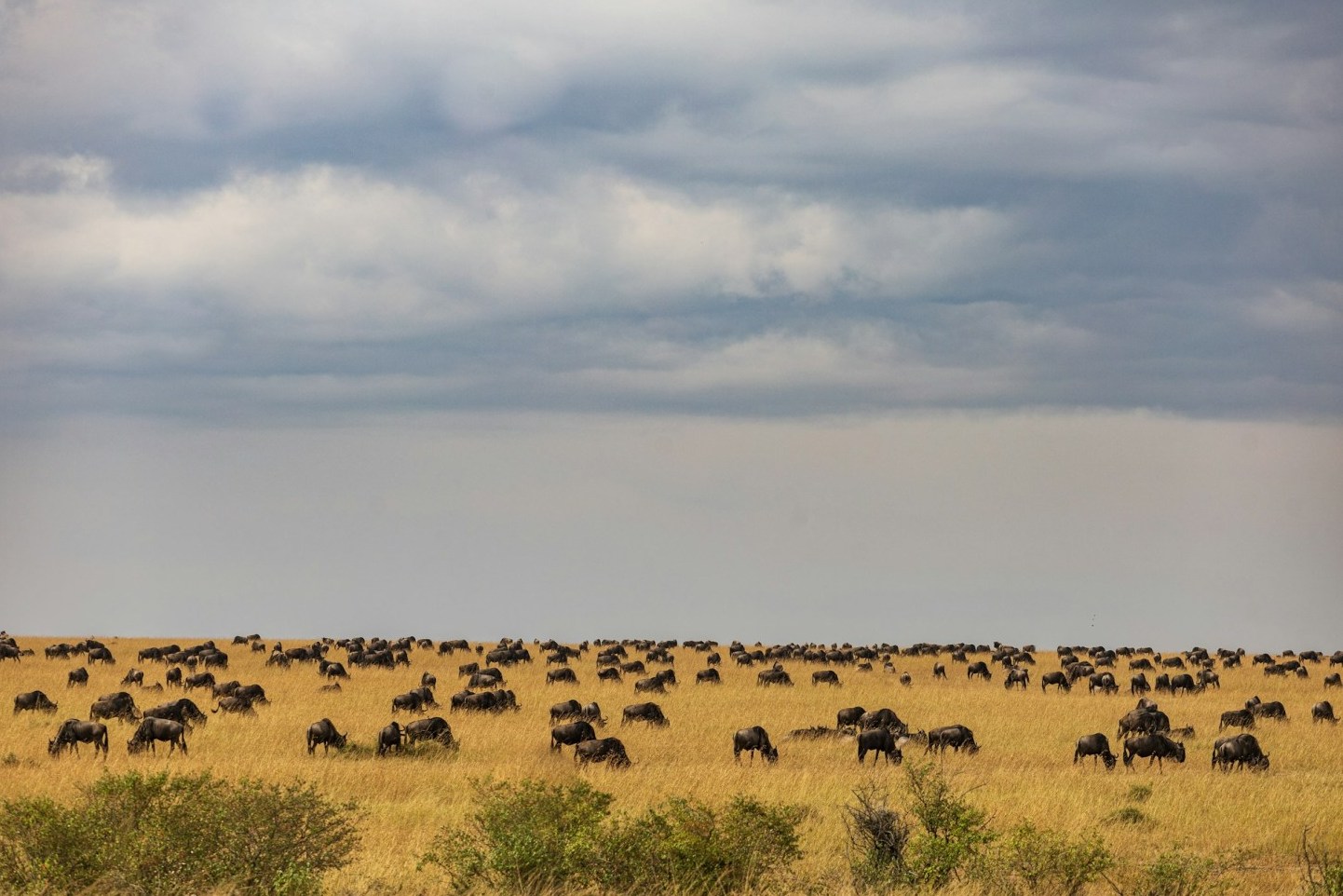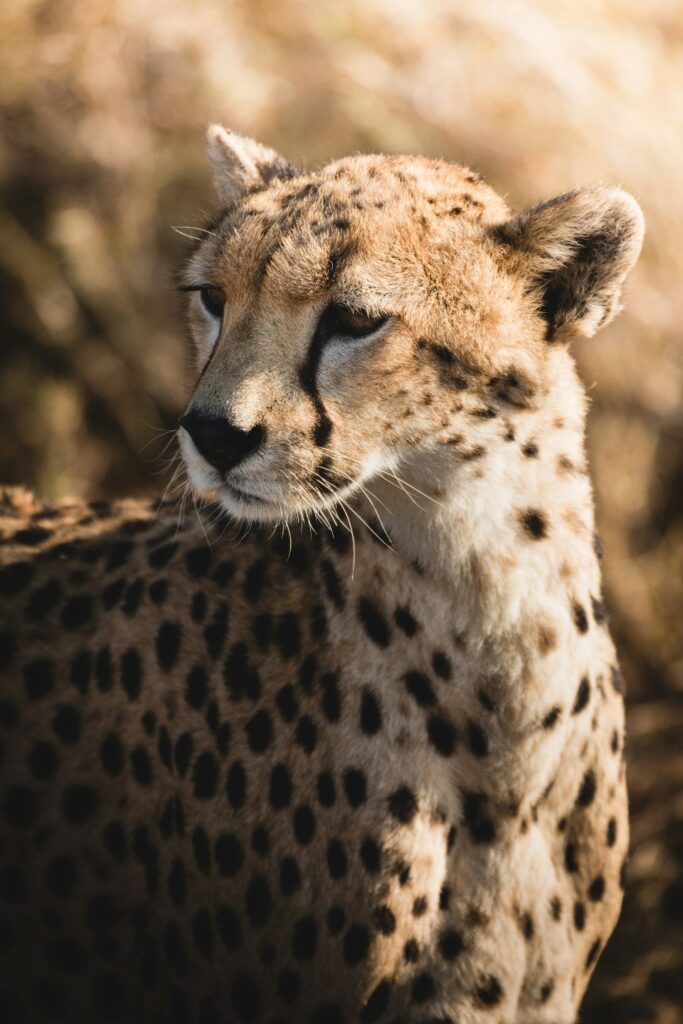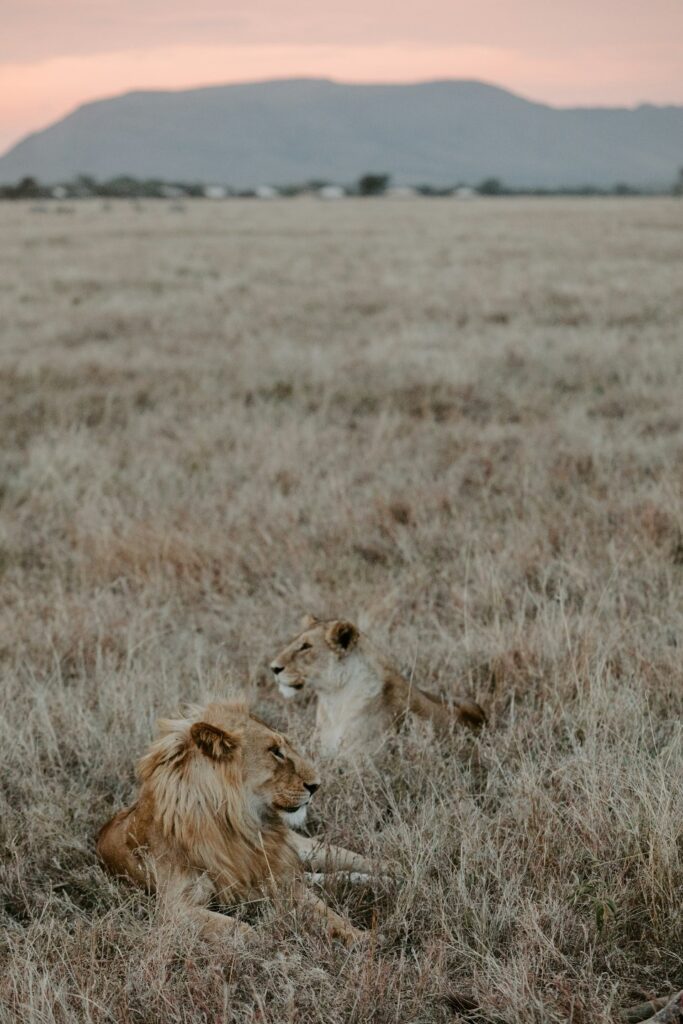
Tanzania Wildebeest Migration Safaris – Follows over a million wildebeest, zebras, and antelopes as they migrate in a year-long circular trek across the Serengeti-Maasai Mara ecosystem in search of fresh pasture.
The best time to see the migration is the calving season in the south (December-March), the journey north through the central Serengeti (April-May), or the dramatic river crossings in the northern Serengeti and Maasai Mara (July-October).
About the Migration – Tanzania’s migrating mega herds bring live actions to every photographer and filmmaker alike… The sights, thunder, sounds and nature’s smell of a million-plus wildebeest and zebra on journeying across the vast Tanzania plains while stalked by hungry predators below and birds of prey from above, is quite spectacular not to be missed by any African guest on a luxury safari.
Whether you’re an African luxury safari novice or a wildlife photographic addict, seeing the great wildebeest migration in Tanzania must be top on your luxury African safari itinerary. Our guide to the Tanzania wildebeest migration safari takes you through the highlights on what you can expect at every stage.
During these periods, birds notably, egrets and oxpeckers can be seen in good numbers patronizing the big herds while taking advantage of the insects that are disturbed by the migrating herds of wildebeest. Join us for a lifetime luxury migration safari as you experience nature’s greatest migration on Earth as hundreds of thousands of anxious herbivores trek for thousands of miles in search of pasture and water in an ancient battle of life and death.
UNDERSTANDING THE BASICS OF THE MIGRATION IN TANZANIA
- In Tanzania, the migration typically begins in the late November or early December, when migrating herds arrive in the southern parts of Tanzania’s Serengeti National Park in the Ndutu area.
- The expansive plains of the Serengeti allow the big heards conglemerations freedom to move wherever they want. It’s a truly magnificent sight of almost two million wildebeests and zebras dispersed throughout the plains of Tanzania’s wilderness, enjoying fresh pasture.
- You can see the Great Migration unlike in Kenya where the great migration only passes through for a few months, Tanzania has an all year round migration. Where they migrate in a circular motion around the Serengeti National Park as such it is an ongoing event.
- The Great Wildebeest Migration is rarely in the Maasai Mara Kenya; the herds only ever venture there as an extension of their grazing lands in the northern point of Tanzania if they need to for fresh pastures. You can only find the migration in Kenya within a few months of the year when they head towards the border, and even then, most of the herds are still mulling around the northern parts of the Serengeti anyway…
Our Tanzania luxury safaris are exclusively dedicated to the wildebeest migration offer comfortable and stylish way to witness the natural spectacle of millions of wildebeest, zebras, and gazelles migrating across the vast Serengeti plains. Our safaris feature high-end accommodations like lodges and mobile camps, often with private guides and exclusive access to prime viewing locations to see dramatic river crossings and predator action. Oluokos wildebeest luxury safaris range from a few days to longer, with prices varying based on the package, duration, and level of luxury. For our case, we’ll offer you the ultra-luxury if you choose to soak into luxury!


Planning for a Wildebeest Migration Safari in Kenya and Tanzania
As a matter of fact, Kenya’s Maasai Mara National Reserve is a more pocket-friendly destination to see the wildebeest migration. Despite having a shorter migration season, as wildebeest only pass here for a maximum of threee months, Kenya offers more flights, more tourist numbers, stiffer competition, and a wide variety of affordable accommodations than its neighbour, Tanzania.
In comparison to Kenya, Tanzania’s size means that travelling beyond the Northern Circuit normally requires domestic flights or longer drives, and this contributes to getting to the parks in the south and west more expensive, time consuming but these generally offer more exclusive wilderness experiences!
As opossed to Maasai Mara, Tanzania’s Serengeti National Park is far much vast than the Maasai Mara, with more exclusive lodges, camps and even to the guests’ surprise with mobile camp in less crowded locations. For your infrmation, the central regions of the Serengeti National Park can still get very busy, so expert advise in selecting your accommodation carefully is key to your enjoyment of the wildebeest migration luxury safari in the Serengeti.
Based on our honest opinion, Kenya is a better option for luxury wildebeest migration safaris, especially to those budget concious and those with limited time to spend on an African luxury safari. For the discerning guests who would want to get away from the safari crowds, explore multiple locations spread over a longer period of safari and splurge as they would wish, Tanzania could be your best destination!





If you would like to safari at the heart of the Great Wildebeest Migration, the best approach is to book one of the Serengeti’s famous mobile camps. The mobile camps are erected at set locations throughout the year, and often move either two or three times a year depending on where the migrating herds usually are at that particular time.
To most our guests desire, two mobile camps in particular set themselves apart from the others for their commitment to keeping up with the herds – Nomad Tanzania’s Serengeti Safari Camp and &Beyond’s Serengeti Under Canvas. These are the two mobile operations which we authentically consider truly mobile and will be located near or amongst the herds at any time of the year as they move to more than two locations.
Other mobile camp options are Alex Walker’s Serian, Asilia’s Olakira, Ubuntu and Kimondo which move twice a year and offer superb mobile operations from July to November, and from December through to March. For the rest of the year these fabulous camps remain closed.
If going mobile is a little too adventurous for you, then the Serengeti has various permanent lodges that will offer all the level of comforts you need together with a good location to see the herds on your Tanzania luxury wildebeest migration safari.
- January – March: Ngororongoro Conservation Area & Ndutu Plains
The Serengeti’s southern huge grass plains extend into the Ngorongoro Conservation Area. From December to March the Serengeti migration congregates in large herds around Lake Ndutu in the Ngorongoro Conservation Area. When it reaches the area the herd splits up and spreads out leaving wildebeest herds as far as the eye can see. Ndutu Lodge and Kusini are the only permanent lodges in the area; Kusini is best towards the end of the period whereas Ndutu Lodge works throughout. Asilia’s Dunia Camp is also a good option at the beginning of December and again when the herds push north in March.
April – May: Central Serengeti & The Western Corridor
This is rainy season in Tanzania. The Wildebeest migration moves north into the plains of the southern Serengeti with front runners stretching out to the Western Corridor and centre of the park at Seronera. Asilia’s Dunia Camp is a great option at this time as are any of the central Serengeti hotels such as the Serena or Sopa. Early herds may well have pushed up to the Grumeti River Camp, Kirawira and Mbalageti Lodge area of the Western Corridor of Serengeti.
- July – October: Maasai Mara, Kenya
June is mating season for the herds, so can be very noisy if you catch many together! By June there are wildebeest herds spread from the Western corridor through the heart of the park. One group tends to head West into the Western Corridor and then crosses the Grumeti River before leaving the park and entering the exclusive Singita Grumeti Reserves. This herd will then head up through the Ikorongo game reserve on the Serengeti’s Western corridor before the front runners arrive into the Kogatende area in July.
The other herds head directly to the north of the Serengeti, passing straight up the middle through Seronera, Lobo and up to the Bologonja river area near the Eastern border with the Loliondo reserve at Kleins. It is true to say that at this time herds can be anywhere from the Western corridor through to the Eastern side of the park.
For your accommodation, we would recommend Grumeti River Camp, Faru Faru, Sasakwa, Sabora, Singita Explore, Mbalageti Lodge and Kirawira for the Western corridor, whereas some herds will have pushed up as far as Migration camp in the Northern Lobo area. Late July will see any of the Kogatende permanent lodges having good migrating herds, Serengeti Lamai and Sayari Camp being the places to go towards the end of July.
- August – October: Maasai Mara, Kenya
From August through to October the herds are in the Northern Serengeti primarilly at Kogatende as well as in Kenya’s Maasai Mara. River crossings often happen daily here. With only a fraction of the visitor numbers that flock to the Mara, Kogatende area makes an exceptional destination. Given that the herds are simply following local rainfall, some move north, some move south… and many move in both directions in the same day. The sprawling mass moves in a circular fashion throughout these months – and as a result this is a fantastic time of year to see the herds.
Guests who aren’t aware of the specific movements of the Migration often make the mistake of assuming the herds head north from June, cross into Kenya and stay there until October, only returning in November when the pastures are all grazed. This would be a logical thought, but it is simply not the reality! You will see at the river crossings, they may cross over, then suddenly cross back the other way – it is not a structured single mass movement but a series of hectic snap decisions “to cross or not to cross”!
- November: Maasai Mara, Kenya – Ndutu Plains, Tanzania
In late October and November the herds start their second Great Migration south towards the fertile lands of the Ndutu plains where the rains will have rejuvenated the grasses since the herds were last there earlier in the year. This can be a tricky time to catch the mega herd, as it covers vast distances every day. By the beginning of December, the herds are returning to Ndutu to calve, and the whole process is ready to start all over again.
We must accept with honesty that wildebeests are not predictable! The migration is also entirely dependent upon rain, with the herds constantly searching for fresh grasses. As a result, it is a challenge to predict with any confidence where the herds will be during any particular week, and therefore to decide where best to stay. Choosing a permanent camp or mobile camp for your Tanzania wiildebeest migration safari that is located in the ‘right’ area for the time of year will clearly increase your chances, but there are no guarantees.





